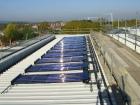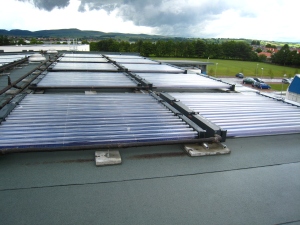Successful solar thermal

Paul Sands of Stokvis Energy Systems offers his view on the value of solar-thermal technology for commercial applications — and the problems that lurk for the unwary.
The story of Icarus flying too close to the Sun and falling into the sea because the heat melted his wings of wax and feathers, is one of Greek mythology’s more vivid images — often being interpreted as a metaphor for hubris or the impetuousness of youth. There is, though, a resonance with the realities of designing solar-thermal systems, where the routes to success can seem as complex as the labyrinth which his father Daedalus created to imprison the Minotaur.
However, there are also obvious attractions to drawing on the energy of the Sun — the vast fusion reactor at the centre of our solar system.
It is, after all, the Sun which is responsible for all life on Earth — warming our atmosphere and fuelling plant growth at the base of the food chain. Its gravitational pull even drives the ocean tides. The energy which reaches the Earth’s surface in a period of just 30 minutes is in fact equivalent to that consumed by humankind in a whole year.
While some of the world’s major economies have now renounced their targets under Kyoto, and the emerging ones are happily building coal-burning power stations to provide their industry’s electricity, the UK Government remains committed to very challenging carbon-reduction targets — now enshrined in law.
Unsurprisingly, solar technologies are very much a part of the Government’s overall strategy. Even though the Feed-in Tariff has been cut back by two-thirds from its original level, the reduction in capital costs for photo-voltaics is still encouraging roof-top arrays and PV ‘farms’ to be installed across the country.
Solar thermal, meanwhile, qualifies under the Renewable Heating Incentive or RHI, which is being expanded in April to embrace residential properties.
Even in the temperate latitudes where Britain lies and with our variable and often wet weather patterns, the UK gets sufficient sunshine to offer quite rapid payback on investment in solar generation with the assistance of the RHI which offsets the capital outlay. However, we should offer the caveat that, as with claiming the Enhanced Capital Allowance, the volume of paperwork involved can prove an obstacle.
The question then is just how best to harvest all that free energy?
Solar-thermal collectors are divided into two main types.
The more basic ones are glazed flat-plate collectors, which typically incorporate copper pipework mounted on a black metal or plastic backing to soak up heat. Unfortunately, the main problem with these is that they also lose heat, and the higher the temperature rises, the lower the efficiency. In fact up to 90% of the energy can be lost through convection and conduction.

Offering far higher efficiencies are evacuated-tube collectors, such as the Ecotube, which Stokvis Energy Systems has been supplying for commercial applications.
The advanced evacuated-tube design ensures its annual performance well exceeds the 528 kWh/m2 quoted as an industry standard. In fact the annual figure achieved is 61% at 850 kWh/m2 each year. Significantly, Ecotubes are unaffected by outside air temperature, and also exhibit far lower ‘parasitic’ losses, so smaller pumps can be employed.
The next significant question for the designer is where into the hot-water system should the harvested energy be introduced?
The arrangement normally preferred for private domestic and smaller scale commercial situations such as guest-houses, shops and primary schools is to utilise a twin-coil solar cylinder. By this means the conventional boiler or, perhaps, a heat pump, feeds the top coil in the tank and will have far less work to do, on average, to heat the water to the required temperature.
The alternative approach, which Stokvis has advocated for many commercial-scale installations, is to link the solar collectors, via a coil, into a preheat tank— from which water is then drawn.
As our Concept Solar technical brochure illustrates, there are several different arrangements by which this approach can be implemented — such as using a plate heat exchanger to ‘top up’ the temperature for the hot-water service as and if appropriate.
To return to the story of Icarus, a key question for the system designer is to decide just how close to the Sun do you approach? The UK typically can achieve 60% of the annual energy required for HWS production from solar energy, but with wide seasonal disparity. This means you must choose whether you size the tank to store the whole of the input available during the peak months, or some median level. If you choose the former, then the boiler or immersion heaters will have more work to do in the winter months, presuming demand remains constant.
This summer bias is also the reason why solar-thermal output is normally used to enhance the DHW service, rather than space heating, though there is potential to link the panels’ output to low-temperature systems, such as underfloor heating systems.
Correctly specified and using the best technologies available, solar-thermal energy can make a very positive impact on the amenity and efficiency of the overall building services provisions in many types of property.








